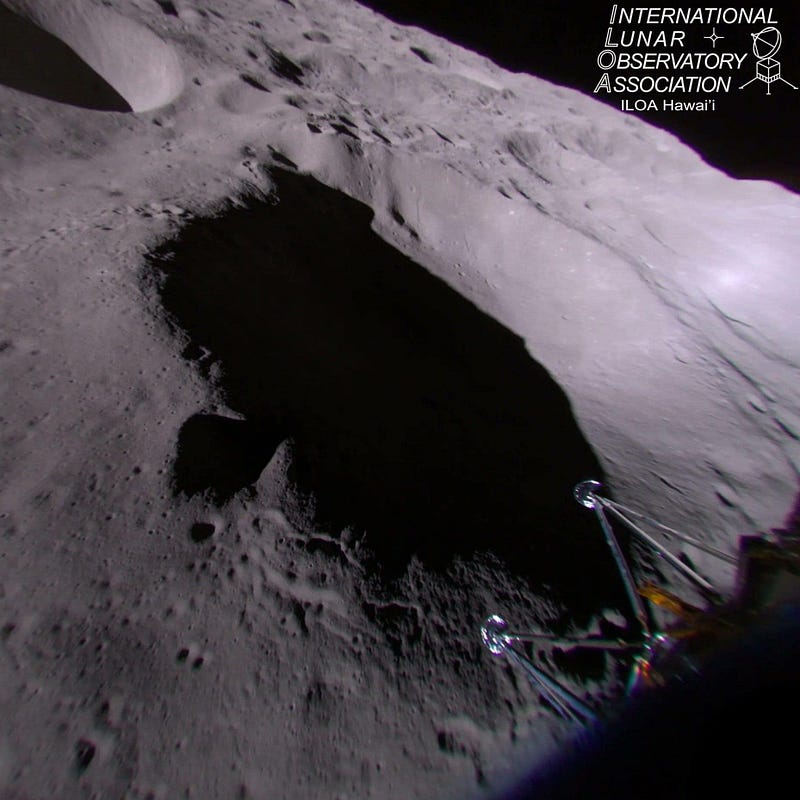# Odysseus Mission: A New Era of Lunar Exploration
Written on
Chapter 1: The Historic Odysseus Mission
The Odysseus mission recently captured a stunning image shortly before its largely successful lunar landing. This oblique shot is a remarkable glimpse into the moon, and I have eagerly anticipated high-resolution footage from lunar orbit since the Apollo missions. Although the craft tipped over, the prospect of exploring the moon soon with the upcoming NASA Artemis-SpaceX-HLS human landing missions is exhilarating. Kudos to Odysseus, Intuitive Machines, and SpaceX for another triumphant launch!

Background and News Overview
The Odysseus mission, carried out by Intuitive Machines, represents a pivotal moment in lunar exploration, being the first U.S. moon landing in over half a century and the inaugural soft landing by a commercial spacecraft. The Nova-C lunar lander, comparable in size to a British phone booth, stood at 4.0 meters tall and 1.57 meters wide while carrying a payload of 100 kg. This included five NASA payloads aimed at showcasing communication, navigation, and precision landing technologies, alongside collecting scientific data from the lunar surface, plus one commercial payload. Notably, a piece from American artist Jeff Koons was included, featuring 125 small stainless steel spheres symbolizing the moon’s phases, intended to honor important historical milestones.
The mission took off on February 15 from NASA’s Kennedy Space Center in Florida, propelled by a SpaceX Falcon 9 rocket. After reaching Earth’s orbit and detaching from the rocket, the lunar lander navigated space using an onboard stellar map, with a planned operational duration of seven days on the moon. However, the mission faced a significant challenge when the craft’s laser navigation system malfunctioned, necessitating reliance on an experimental NASA laser system, the Navigation Doppler Lidar, for landing guidance.
This last-minute adjustment proved effective, leading to Odysseus’s successful landing on February 23 at 6:23 PM EST (23:23 GMT) after a 400,000 km journey. Despite initial fears surrounding communication delays, the lander soon confirmed its transmission of data shortly after touchdown.
Section 1.1: Challenges Post-Landing
Following its historic landing, the Odysseus lunar lander encountered an unexpected challenge, coming to rest on its side. Nevertheless, the lander continues to transmit data back to Earth. This issue arose when the lander tipped over due to uneven terrain on the moon, resting against a rock. The mission team has maintained contact with Odysseus and successfully analyzed data from both commercial and scientific payloads aboard the spacecraft.
Although its sideways position has limited certain functionalities—affecting one solar panel and two antennas—the mission is still considered a success. Most of NASA's scientific and technological payloads are intact and operational for communication. The secondary solar array remains functional, ensuring the lander's batteries stay charged.
The first video showcases the live streaming of the Odysseus lunar mission's attempts at the first private moon landing, highlighting the significance of this event.
Section 1.2: Future Implications of Odysseus
This mission is notable for several reasons, including being the first commercially-built lander to reach the lunar surface and the first American spacecraft to do so since the Apollo era. Despite overcoming 11 critical challenges throughout the journey, including communication delays and difficulties during burn maneuvers, the mission has provided valuable insights into the operation of its liquid methane and liquid oxygen propulsion system in deep space.
NASA considers the Odysseus mission as foundational for future commercial partnerships in space exploration. As part of NASA’s Commercial Lunar Payload Services program, this mission has yielded critical data that will support the agency’s Artemis moon missions and future Mars expeditions. The success of Odysseus, despite its landing position, emphasizes the potential role of commercial entities in the exploration of the moon and beyond.
Chapter 2: Preparing for Future Lunar Exploration
The landing of Odysseus is part of NASA’s broader initiative to prepare for human exploration of the moon, particularly targeting the lunar south pole, which is believed to contain water ice. This exploration aims to gather essential data to facilitate the establishment of a permanent lunar base and to serve as a launch pad for future Mars missions. The mission marks a paradigm shift in space exploration, focusing on commercial partnerships and the growth of a lunar economy, wherein private companies significantly contribute to advancing lunar exploration.
The second video features live streaming of the Odysseus Lander's attempt at a historic moon landing, providing viewers with real-time insights into this groundbreaking endeavor.